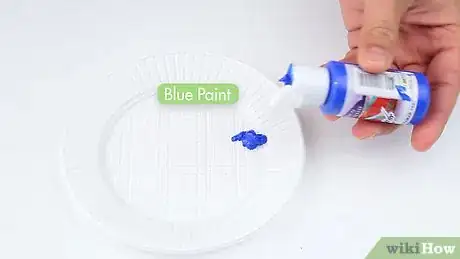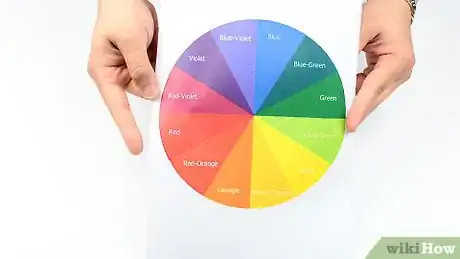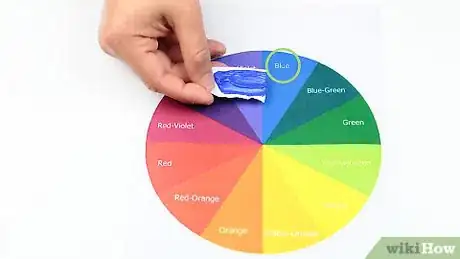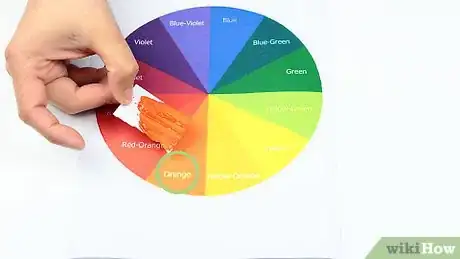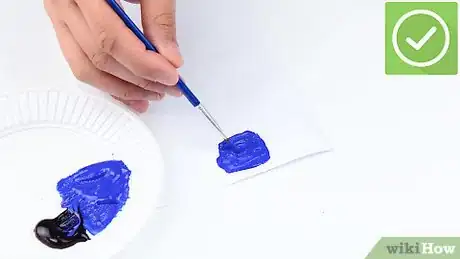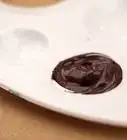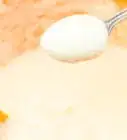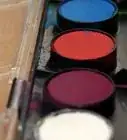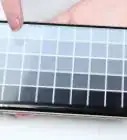This article was co-authored by Renée Plevy. Renée Plevy is an Internationally Acclaimed Portrait Artist from New York/Palm Beach who has painted The Grand Dames of Palm Beach and various celebrities and community leaders. With over 50 years of experience, Renée specializes in painting realistically in oil and capturing the soul of the person. She has studied under internationally renowned portrait artists John Howard Sanden, David Leffel, Robert Beverly Hale, Clyde Smith, and Leonid Gervits. Renée is featured in over 68 shows and galleries including a one-woman museum show at the Paterson Museum. She has garnered numerous awards including “Artist of the Year” from The Bloomfield Art League and First Prize from the Boca Raton Museum Artist’s Guild. Renée has even painted a portrait of celebrity, Vanilla Ice. She also teaches at the Boca Raton Museum Art School - formerly at SVA in Manhattan.
This article has been viewed 557,712 times.
Creating a darker shade of blue can be achieved by simply mixing your current blue with another color. Learning to mix your colors will greatly expand the options you will have at your fingertips for any project. There are several colors you can add to blue to darken the shade. Carefully adding one of these colors to your current shade of blue will give you the control to create the perfect dark blue for your project.[1]
Steps
Adding Black to Blue
-
1Squeeze the amount of blue paint you will need for your project onto your palette. Make sure that you have enough paint to complete the coverage needed with this shade of dark blue. Once you have mixed the perfect hue, it could be difficult to match this shade a second time. It’s always better to make more dark blue than you need rather than run out.[2]
- If you do not complete your project, you can store your excess paint in an airtight container like a plastic container you would use to store leftover food.
- Consider wetting a paper towel or sponge and placing it in the bottom of your container, or using a Sta-Wet Palette to keep your paint from drying out.
-
2Place a small amount of black paint next to the blue paint on your palette. Avoid putting the black paint directly on top of the blue paint. Placing it next to the blue will allow you to add a little black at a time and give you more control over the shade.Advertisement
-
3Drag your brush through the edge of the puddle of black paint and pull a small amount of black into the blue paint. Be sure not to take much black paint on your first attempt. Black is a very strong color and a small amount will have a large effect.
-
4Mix the black into the blue paint a little at a time. Fold the colors together using a mixing tool or cross-hatch strokes with your paint brush. You don't need to mix too thoroughly, which could dull the color. Just combine the paint enough to assess the shade.[3]
-
5Add more black paint and mix as necessary until you reach your desired shade of blue. This could take several repetitions of adding black to the blue paint, but continue to use small amounts so you don't exceed the level of darkness you wish to create.
- If you accidentally mix too much black into the blue, have some extra blue paint on hand to even out the ratio.
Combining Complementary Colors
-
1Print out a color wheel. A color wheel presents the primary colors of red, yellow and blue, as well as all of the colors created by combining these primary colors to create others. There are basic color wheels which use only the primary and secondary colors. Consider using an advanced wheel which includes various tints, hues and shades.
-
2Find the exact placement on the color wheel of the specific hue of blue paint you are beginning with. In order to identify the complementary color, you need to start with the exact placement of your blue paint on the color wheel. Don’t judge the hue based on the title of the paint. Rather, apply the paint to a small bit of white paper and allow it to dry. Compare this color to the color wheel and match the hue to the most accurate section of the wheel.[4]
-
3Identify the shade of orange which is complementary to your shade of blue. A complementary color is the color directly across the wheel from the blue you have identified. This should be some version of orange and is the color you will mix with your blue to darken it.[5]
- A good place to start would be mixing Burnt Sienna with Ultramarine Blue.
- Another possible color combination is Cadmium Orange and Cobalt Blue.
-
4Squeeze enough blue paint onto your palette to complete the coverage necessary with this shade of blue. It is better to have too much paint than too little in order to avoid having to mix more and attempt to match your shade a second time.
- It is a good idea to save some of your blue paint in case you add too much orange and need to adjust the shade by adding blue back into your mixture.
-
5Add a small amount of the orange paint next to the blue paint on your palette. It is best to keep the orange near the blue and mix a little at a time. You will want enough to work with, but you do not need as much orange paint as blue paint.[6]
-
6Drag your brush or palette knife tool through the edge of the orange paint and into the blue paint. Be sure not to take much orange paint on your first attempt. Adding only a little orange at a time will give you the chance to see how it changes the shade of blue.
-
7Mix the orange paint into the blue. Fold the orange paint into the blue paint using a mixing tool like a palette knife or make cross-hatches with your paint brush. Using complementary colors can create a vibrant dark blue, so it is best to avoid too much mixing. Allow just enough to asses the shade and keep from dulling the color.[7]
-
8Add more orange a little at a time until you reach the desired shade of blue. Avoid the urge to move on to adding larger amounts of orange. If the orange exceeds blue, you will be moving away from dark blue and blend into a shade of orange. Continue adding small amounts of orange and assessing the outcome until you create your perfect shade of dark blue.
- If you accidentally mix too much orange into the blue, have some extra blue paint on hand to even out the ratio.
Mixing Analogous Colors to Make a Color Combination
-
1Pour some blue and purple paint on your palette. Purple, or violet, is an analogous color to blue, found next to it on the color wheel. Make sure that you have enough paint to work with. You will want more blue paint as your base color, than your purple mixing color.
-
2Mix a small amount of purple paint into the original blue. You can use your brush or a palette knife to mix your paint.[8] Add a small amount of purple at a time in order to control the color combination and create a violet-blue.
-
3Test your paint color. Many paints, including acrylics, will darken when they dry. Acrylics dry quickly, so you can easily test your paint color by painting a small amount on your canvas and allowing it to dry. This should take no longer than 15 minutes, and will allow you to see the ultimate color before you use this shade for your project.[9]
- If you are unhappy with the dried color, go back to your palette and adjust it by adding more blue or purple accordingly.
Community Q&A
-
QuestionWhat color will ocean blue and dark forest brown make together?
 Community AnswerOcean blue and dark forest brown usually combine to form a very dark green. If you mix these colors, you might find that you don't always get the dark green, so you have to watch how much of each color you add. A good tip is to start with the lighter color and add just a little bit of the darker color at a time until you reach your desired shade.
Community AnswerOcean blue and dark forest brown usually combine to form a very dark green. If you mix these colors, you might find that you don't always get the dark green, so you have to watch how much of each color you add. A good tip is to start with the lighter color and add just a little bit of the darker color at a time until you reach your desired shade. -
QuestionHow do I make green with out any blue?
 Community AnswerAdd a small dot of black paint to yellow. If you want a lighter green, you can always add white. It's better not to saturate the color too much (white isn't the solution to all problems) so it's more convenient to have blue in order to make green. If you really can't have blue, then yellow, black and white paint will do the job satisfactorily.
Community AnswerAdd a small dot of black paint to yellow. If you want a lighter green, you can always add white. It's better not to saturate the color too much (white isn't the solution to all problems) so it's more convenient to have blue in order to make green. If you really can't have blue, then yellow, black and white paint will do the job satisfactorily. -
QuestionDo I just add black to the regular blue or do I have to combine other colors to make a dark blue?
 Community AnswerJust black. But you have to be careful and add just a little bit at a time until you've got your desired color.
Community AnswerJust black. But you have to be careful and add just a little bit at a time until you've got your desired color.
Warnings
- When mixing and using paint, always work in a well-ventilated area.⧼thumbs_response⧽
- It can be difficult to match the exact same color again when you're a beginner, so be sure to make enough to begin with. As you become more experienced, it starts to get easier to reproduce the new color that you've created, with practice and a trained eye.⧼thumbs_response⧽
Things You'll Need
- Palette (an artist's palette, ice cream container lid, old plate, etc.)
- Palette knife, wooden craft stick, etc.
- Paint
References
- ↑ http://www.enchantedlearning.com/art/Colormixing.shtml
- ↑ http://www.art-is-fun.com/difficulties-reproducing-the-same-color-with-acrylics/
- ↑ http://www.visual-arts-cork.com/artist-paints/colour-mixing-tips.htm
- ↑ http://www.realcolorwheel.com/complementsneutral.htm
- ↑ http://www.realcolorwheel.com/complementsneutral.htm
- ↑ http://willkempartschool.com/beginners-colour-mixing-acrylic-paint/
- ↑ http://www.visual-arts-cork.com/artist-paints/colour-mixing-tips.htm
- ↑ http://www.explore-acrylic-painting.com/painting-tools.html
- ↑ http://www.dummies.com/how-to/content/quick-tips-for-using-acrylic-paints.html
About This Article
The easiest way to make dark blue paint is by mixing black paint into blue paint a little at a time. The more black you add, the darker the blue paint will become. Alternatively, you can mix orange paint into blue paint a little at a time until you get a darker shade of blue. Be careful not to mix too much orange in since you’ll end up with brown if you add too much. Another option is to mix a small amount of purple paint into your blue paint, which will give you a darker, violet shade of blue. If you want to learn how to darken blue paint with purple or orange, keep reading!
